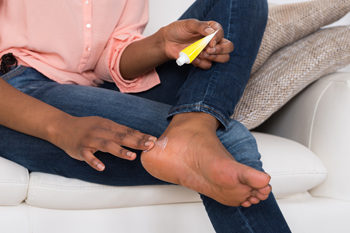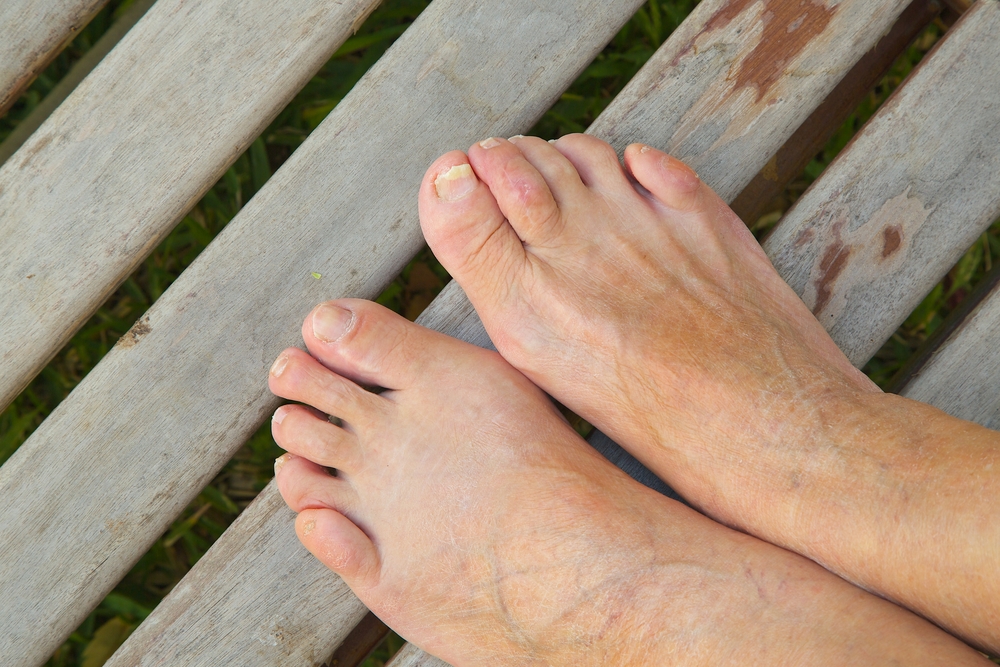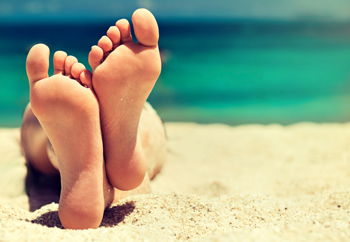Items filtered by date: December 2020
The Early Warning Sign of Blisters
 A foot blister is a common condition typically caused by excess friction on the skin of the foot. This friction is usually due to shoes or socks rubbing against the skin. Blisters occur when the top layer of skin separates from the lower layers of skin, forming a fluid-filled bubble on the surface of the foot. These bubbles can become painful, especially if they continue to experience friction. The first symptom of a developing blister may be a “hot spot,” an area on your foot that begins to feel hot and irritated as you walk or run. If this early sign is ignored, a blister will then form in the “hot spot” area and may cause discomfort and pain. If the blistered area continues to endure too much friction, the blister will pop, which can increase the risk of infection. For more information about foot blisters, please speak with a podiatrist today.
A foot blister is a common condition typically caused by excess friction on the skin of the foot. This friction is usually due to shoes or socks rubbing against the skin. Blisters occur when the top layer of skin separates from the lower layers of skin, forming a fluid-filled bubble on the surface of the foot. These bubbles can become painful, especially if they continue to experience friction. The first symptom of a developing blister may be a “hot spot,” an area on your foot that begins to feel hot and irritated as you walk or run. If this early sign is ignored, a blister will then form in the “hot spot” area and may cause discomfort and pain. If the blistered area continues to endure too much friction, the blister will pop, which can increase the risk of infection. For more information about foot blisters, please speak with a podiatrist today.
Blisters are prone to making everyday activities extremely uncomfortable. If your feet are hurting, contact Dr. Mark Gagnon of Advanced Podiatry. Our doctor can provide the care you need to keep you pain-free and on your feet.
Foot Blisters
Foot blisters develop as a result of constantly wearing tight or ill-fitting footwear. This happens due to the constant rubbing from the shoe, which can often lead to pain.
What Are Foot Blisters?
A foot blister is a small fluid-filled pocket that forms on the upper-most layer of the skin. Blisters are filled with clear fluid and can lead to blood drainage or pus if the area becomes infected.
How Do Blisters Form?
Blisters on the feet are often the result of constant friction of skin and material, usually by shoe rubbing. Walking in sandals, boots, or shoes that don’t fit properly for long periods of time can result in a blister. Having consistent foot moisture and humidity can easily lead to blister formation.
Prevention & Treatment
It is important to properly care for the affected area in order to prevent infection and ease the pain. Do not lance the blister and use a Band-Aid to provide pain relief. Also, be sure to keep your feet dry and wear proper fitting shoes. If you see blood or pus in a blister, seek assistance from a podiatrist.
If you have any questions, please feel free to contact one of our offices located in Crestwood, Orland Park, and Summit, IL . We offer the newest diagnostic and treatment technologies for all your foot care needs.
Easing the Pain of Cracked Heels
 Wearing certain shoes may caused cracked heels. Flips flops are generally included in this category, and can cause the skin on the heels to become dry. This may lead to fissures forming, which can become painful and uncomfortable. It is beneficial to start treating cracked heels as quickly as possible, as this may help to prevent fissures, bleeding and infection. Effective treatment methods can begin with removing the dry skin from your heels. This can be done by using a pumice stone, followed by applying a good moisturizer on the affected area. It can help to drink plenty of fresh water daily, and walking instead of running may help to alleviate some of the pressure on the feet, which may contribute to cracked heels. If your cracked heels are severe and do not heal through home treatment, it is recommended that you consult with a podiatrist who can offer you additional treatment options.
Wearing certain shoes may caused cracked heels. Flips flops are generally included in this category, and can cause the skin on the heels to become dry. This may lead to fissures forming, which can become painful and uncomfortable. It is beneficial to start treating cracked heels as quickly as possible, as this may help to prevent fissures, bleeding and infection. Effective treatment methods can begin with removing the dry skin from your heels. This can be done by using a pumice stone, followed by applying a good moisturizer on the affected area. It can help to drink plenty of fresh water daily, and walking instead of running may help to alleviate some of the pressure on the feet, which may contribute to cracked heels. If your cracked heels are severe and do not heal through home treatment, it is recommended that you consult with a podiatrist who can offer you additional treatment options.
If the skin on your feet starts to crack, you may want to see a podiatrist to find treatment. If you have any concerns, contact Dr. Mark Gagnon from Advanced Podiatry. Our doctor can provide the care you need to keep you pain-free and on your feet.
Cracked Heels
It is important to moisturize your cracked heels in order to prevent pain, bleeding, and infection. The reason cracked heels form is because the skin on the foot is too dry to support the immense pressure placed on them. When the foot expands, the dry skin on the foot begins to split.
Ways to Help Heal Them
- Invest in a good foot cream
- Try Using Petroleum Jelly
- Ease up on Soaps
- Drink Plenty of Water
Ways to Prevent Cracked Heels
- Moisturize After Showering
- Skip a Shower
- Keep Shower Water Lukewarm
- Don’t Scrub Your Feet
If you are unsure how to proceed in treating cracked heels, seek guidance from a podiatrist. Your doctor will help you with any questions or information you may need.
If you have any questions, please feel free to contact one of our offices located in Crestwood, Orland Park, and Summit, IL . We offer the newest diagnostic and treatment technologies for all your foot care needs.
Treatments for Extra Sweaty Feet
Plantar hyperhidrosis is a condition that causes excessively sweaty feet. Fortunately, there are multiple treatments available for it. Botox injections into the foot can reduce excessive sweat production by blocking a chemical in the body that stimulates sweat glands. Results typically last for 4-6 months. Application of an antiperspirant to the feet is a less invasive way to reduce sweating. The antiperspirant decreases the flow of sweat from the sweat ducts along the surface of the skin by forming a shallow plug in the ducts. Other treatment options include iontophoresis, wearing moisture-absorbing shoe inserts, and applying powders to the feet. If you are afflicted with sweaty feet it is recommended that you consult with a podiatrist to learn more about treatment options and determine one that is correct for you.
If you are suffering from hyperhidrosis contact Dr. Mark Gagnon of Advanced Podiatry. Our doctor can provide the care you need to attend to all of your foot and ankle needs.
Hyperhidrosis of the Feet
Hyperhidrosis is a rare disorder that can cause people to have excessive sweating of their feet. This can usually occur all on its own without rigorous activity involved. People who suffer from hyperhidrosis may also experience sweaty palms.
Although it is said that sweating is a healthy process meant to cool down the body temperature and to maintain a proper internal temperature, hyperhidrosis may prove to be a huge hindrance on a person’s everyday life.
Plantar hyperhidrosis is considered to be the main form of hyperhidrosis. Secondary hyperhidrosis can refer to sweating that occurs in areas other than the feet or hands and armpits. Often this may be a sign of it being related to another medical condition such as menopause, hyperthyroidism and even Parkinson’s disease.
In order to alleviate this condition, it is important to see your doctor so that they may prescribe the necessary medications so that you can begin to live a normal life again. If this is left untreated, it is said that it will persist throughout an individual’s life.
A last resort approach would be surgery, but it is best to speak with your doctor to find out what may be the best treatment for you.
If you have any questions please feel free to contact one of our offices located in Crestwood, Orland Park, and Summit, IL . We offer the newest diagnostic and treatment technologies for all your foot and ankle needs.
Why Do I Have Hammertoes?
 Hammertoes are a type of toe deformity that cause the ends of the affected toes to bend downward at the middle joint. At first, the affected toes may be flexible, but over time, the joints can become stiff, leaving the toes stuck in a claw-like position. The most common cause of hammertoes is wearing shoes that are too narrow and tight, which cause the toes to bend upward. Muscles and tendons within the affected toes become tighter and shorter, causing the toe to remain in a bent position long after you have taken off the shoes. Risk factors that increase your risk of developing hammertoes also include having longer toes, bunions, or rheumatoid arthritis. Hammertoes can cause pain and discomfort, make it difficult to wear shoes, and increase your chances of getting corns, calluses, and blisters on your toes. If you have hammertoes, it is suggested that you seek the care of a podiatrist.
Hammertoes are a type of toe deformity that cause the ends of the affected toes to bend downward at the middle joint. At first, the affected toes may be flexible, but over time, the joints can become stiff, leaving the toes stuck in a claw-like position. The most common cause of hammertoes is wearing shoes that are too narrow and tight, which cause the toes to bend upward. Muscles and tendons within the affected toes become tighter and shorter, causing the toe to remain in a bent position long after you have taken off the shoes. Risk factors that increase your risk of developing hammertoes also include having longer toes, bunions, or rheumatoid arthritis. Hammertoes can cause pain and discomfort, make it difficult to wear shoes, and increase your chances of getting corns, calluses, and blisters on your toes. If you have hammertoes, it is suggested that you seek the care of a podiatrist.
Hammertoe
Hammertoes can be a painful condition to live with. For more information, contact Dr. Mark Gagnon from Advanced Podiatry. Our doctor will answer any of your foot- and ankle-related questions.
Hammertoe is a foot deformity that affects the joints of the second, third, fourth, or fifth toes of your feet. It is a painful foot condition in which these toes curl and arch up, which can often lead to pain when wearing footwear.
Symptoms
- Pain in the affected toes
- Development of corns or calluses due to friction
- Inflammation
- Redness
- Contracture of the toes
Causes
Genetics – People who are genetically predisposed to hammertoe are often more susceptible
Arthritis – Because arthritis affects the joints in your toes, further deformities stemming from arthritis can occur
Trauma – Direct trauma to the toes could potentially lead to hammertoe
Ill-fitting shoes – Undue pressure on the front of the toes from ill-fitting shoes can potentially lead to the development of hammertoe
Treatment
Orthotics – Custom made inserts can be used to help relieve pressure placed on the toes and therefore relieve some of the pain associated with it
Medications – Oral medications such as anti-inflammatories or NSAIDs could be used to treat the pain and inflammation hammertoes causes. Injections of corticosteroids are also sometimes used
Surgery – In more severe cases where the hammertoes have become more rigid, foot surgery is a potential option
If you have any questions please contact one of our offices located in Crestwood, Orland Park, and Summit, IL . We offer the newest diagnostic and treatment technologies for all your foot and ankle needs.


